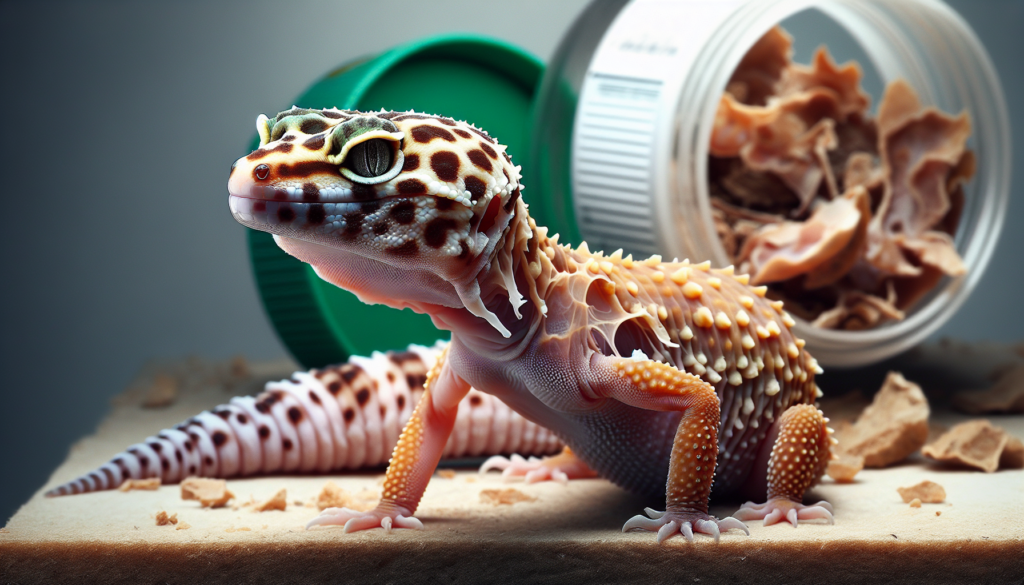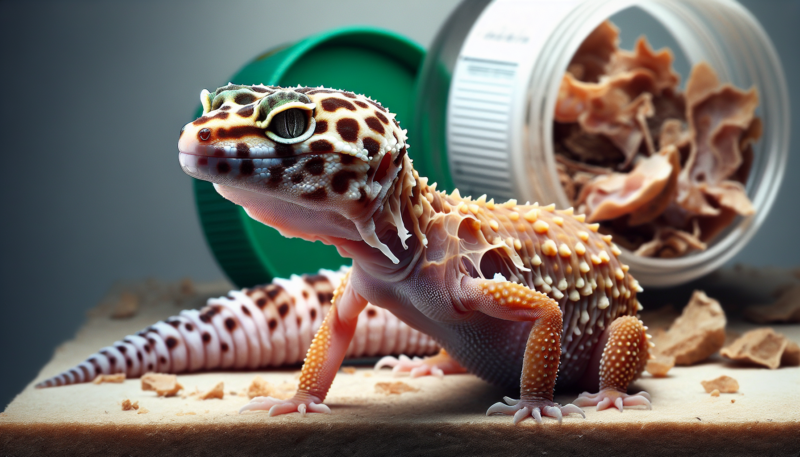If you’re a proud owner of a leopard gecko, you may have noticed that these adorable creatures occasionally go through a shedding process. Shedding is a natural occurrence for leopard geckos, but it’s essential to provide them with some assistance to ensure a smooth and successful shed. In this article, you’ll discover some practical tips and techniques on how to help your leopard gecko shed its old skin comfortably. So, grab your reptile-friendly moisturizer and get ready to become an expert in leopard gecko shedding care!

Understanding Leopard Gecko Shedding
Leopard geckos, with their vibrant colors and unique patterns, are fascinating pets to have. One important aspect of their care is understanding the shedding process. Shedding is a natural and necessary process for leopard geckos to grow and maintain healthy skin. In this article, we will discuss the importance of shedding, signs that indicate your gecko is ready to shed, and potential problems that can occur during the shedding process.
The Importance of Shedding for Leopard Geckos
Shedding is a vital process for leopard geckos as it allows them to rejuvenate their skin and remove any old or damaged layers. During shedding, the gecko’s skin becomes dry and starts to peel off. Once the process is complete, the gecko reveals fresh, vibrant skin. Shedding also enables the gecko to get rid of any external parasites that may have latched onto its old skin. Therefore, understanding and facilitating the shedding process is crucial for the overall well-being and health of your leopard gecko.
Signs that a Leopard Gecko is Ready to Shed
Leopard geckos exhibit various signs that indicate they are about to shed. By observing these signs, you can anticipate when your gecko is preparing for this important process. One of the most common signs is a change in your gecko’s appearance. You may notice that its skin appears dull or cloudy. Additionally, the gecko’s eyes may become noticeably paler or have a milky appearance. Reduced appetite and increased restlessness are also common signs that your leopard gecko is getting ready to shed its skin. By being vigilant and noticing these signs, you can make appropriate preparations to aid your gecko during the shedding process.
Problems that Can Occur During Shedding
While shedding is a natural process, it can sometimes be accompanied by difficulties. One common issue is the retention of eyecaps. Leopard geckos have a thin layer of transparent skin covering their eyes, and during shedding, this skin can fail to come off completely, leading to retained eyecaps. This can be painful and debilitating for the gecko if not addressed promptly. Another problem that can arise is tail retention, where the gecko’s tail does not shed fully, causing it to become constricted or stuck. Both of these issues can have serious implications for the health of your leopard gecko. Therefore, it is essential to know how to assist your gecko during shedding and when to seek veterinary assistance.
Creating a Suitable Environment for Shedding
To ensure a successful shedding process for your leopard gecko, it is important to provide an environment that supports and facilitates shedding. This includes maintaining proper temperature and humidity levels, providing adequate hiding places, using moist hides, and avoiding stressful disturbances.
Maintaining Proper Temperature and Humidity
Leopard geckos require specific temperature and humidity conditions to shed successfully. The temperature in the enclosure should be maintained between 88-92°F during the day and slightly cooler at night. A temperature gradient allows the gecko to choose between warmer and cooler areas. Additionally, the humidity level should be around 40-60% to prevent the gecko’s skin from drying out excessively. Using a reliable thermometer and hygrometer to monitor these factors is crucial.
Providing Adequate Hiding Places
Leopard geckos are known for their love of hiding, especially during shedding. It is important to provide multiple hiding places in their enclosure to replicate their natural habitat. Hides should be available on both the warm and cool sides of the enclosure, allowing the gecko to choose its preferred temperature. Providing suitable hiding spots reduces stress and anxiety, which can negatively impact the shedding process.
Using Moist Hides
Moist hides play a significant role in aiding the shedding process for leopard geckos. These hides are created by placing a damp substrate, such as moss or paper towels, inside a hide. The moisture helps to soften the gecko’s old skin, making it easier to shed. Moist hides should be available both on the warm and cool sides of the enclosure. This ensures that the gecko has access to the preferred temperature while benefiting from the moisture.
Avoiding Stressful Disturbances
During the shedding process, leopard geckos can become more sensitive and easily stressed. It is essential to minimize any disturbances that may disrupt their routine or cause anxiety. Avoid excessive handling or sudden loud noises near their enclosure. Maintaining a calm and quiet environment will help your gecko feel secure and relaxed, allowing for a smoother shedding process.
Assisting with the Shedding Process
While leopard geckos are usually capable of shedding on their own, there are times when they may require assistance. As a responsible pet owner, it is essential to know the appropriate methods to help your gecko during the shedding process.
Misting the Enclosure
Misting the enclosure with tepid water can help increase humidity levels, which is beneficial during shedding. Use a spray bottle to mist the enclosure’s walls and substrate without directly spraying the gecko. The increased humidity will help soften the gecko’s old skin and facilitate shedding.
Offering a Moist Hide
In addition to misting the enclosure, providing a specifically designed moist hide can be extremely helpful. This hide is created by placing damp moss or paper towels in a designated container. The gecko can use this hide to spend time in a moist environment, aiding the shedding process. Ensure that the hide is easily accessible and positioned near the gecko’s preferred temperature.
Providing a Rough Surface
Sometimes, leopard geckos may struggle to shed their skin completely, particularly on their feet. You can assist by providing a rough surface, such as a piece of slate or rough carpet, in the enclosure. The gecko can rub against this surface to help remove any stubborn pieces of old skin.
Gently Bathing the Gecko
If your leopard gecko is experiencing extreme difficulty shedding or has retained eyecaps, a gentle bath can provide relief. Prepare a shallow dish with lukewarm water and allow the gecko to soak for a few minutes. This can help soften the skin and facilitate the shedding process. However, it is important to avoid keeping the gecko submerged for too long to prevent stress or drowning.
Dealing with Difficulties during Shedding
Despite your best efforts, leopard geckos may still encounter difficulties during shedding. It is crucial to address these issues promptly to ensure the gecko’s health and well-being.
Handling a Retained Eyecap
If you notice that your gecko has retained an eyecap during shedding, it is important to take action. Attempting to remove the eyecap yourself can cause injury to the gecko’s delicate eyes. Instead, consult a reptile veterinarian or an experienced reptile keeper for guidance. They can safely assess the situation and provide the necessary assistance to remove the retained eyecap.
Addressing Tail Retention
Tail retention occurs when the gecko’s tail doesn’t shed properly or becomes constricted by old skin. This can lead to serious complications if left untreated. If you suspect tail retention in your leopard gecko, it is essential to seek veterinary assistance. A reptile veterinarian can assess the situation and determine the best course of action, which may involve removing the retained shed or providing medical intervention.
Seeking Veterinary Assistance
If you encounter any difficulties or concerns during your gecko’s shedding process, it is advisable to consult a reptile veterinarian. These professionals have the expertise to identify and address any underlying issues that may be hindering the gecko’s shedding. Regular check-ups with a reptile veterinarian can also help prevent potential problems and ensure the overall health and well-being of your leopard gecko.

Preventing Future Shedding Issues
Taking proactive measures to prevent future shedding issues is essential for the long-term health of your leopard gecko. By following a few guidelines, you can minimize the likelihood of complications arising during the shedding process.
Regularly Check the Enclosure
Frequently monitoring and maintaining the enclosure is crucial to prevent shedding difficulties. Regularly check the temperature and humidity levels, ensuring they remain within the appropriate range. Inspect the hides for any signs of mold or mildew, as these can impact the gecko’s health. Additionally, ensure the substrate is clean and free from debris that may hinder shedding.
Ensure a Proper Diet
A well-balanced diet is essential for a leopard gecko’s overall health, including its shedding process. Provide a variety of gut-loaded insects, such as crickets or mealworms, as the main source of food. Additionally, ensure that the gecko’s diet is supplemented with calcium and vitamins to support healthy skin and shedding. Consult a reptile veterinarian for specific dietary recommendations based on your gecko’s age and individual needs.
Monitoring the Gecko’s Health
Regularly monitoring your gecko’s health is crucial for identifying any potential issues early on. Observe their behavior, appetite, and overall appearance. If you notice any changes or abnormalities, such as weight loss, lethargy, or skin abnormalities, seek veterinary advice promptly. Early detection and intervention can prevent shedding complications and ensure the well-being of your leopard gecko.
Conclusion
Understanding and assisting with the shedding process is a fundamental aspect of leopard gecko care. By recognizing the signs of shedding, creating a suitable environment, and providing necessary assistance, you can help your gecko shed successfully and maintain healthy skin. Remember to monitor your gecko’s health, seek veterinary advice when needed, and take preventive measures to minimize future shedding issues. With proper care and attention, you can ensure that your leopard gecko experiences smooth and trouble-free shedding throughout its life.
